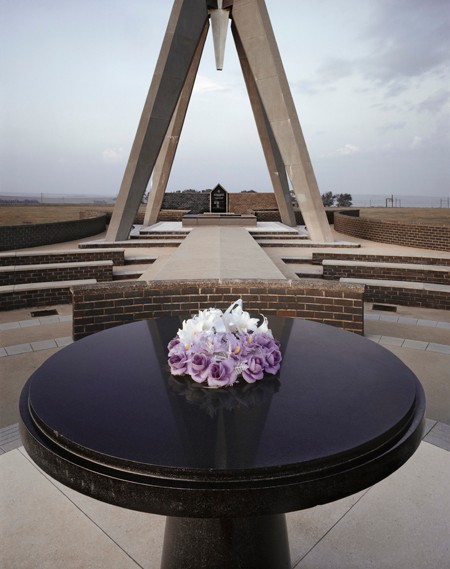Reviewing David Goldblatt’s exhibition Structures Here (1985), art critic and University of the Witwatersrand drama professor John Van Zyl homed in on the anomalous inclusion of a single color photograph amid black-and-white prints. Walking his readers through the exhibition, Van Zyl described compelling images of structures that evidenced what life was like in South Africa in the time of
Fourteen years later, Goldblatt embarked on his first long-term photographic series entirely produced in color, Intersections. Not alone in exploring more possibilities for color, Goldblatt (b. 1930)—along with younger artists predominantly associated with socially concerned work in black and white, such as Santu Mofokeng (b. 1956), Gideon Mendel (b. 1959), and Guy Tillim (b. 1962)—experimented with making color photographs for personally directed projects in the 1990s and early 2000s. Somewhere between wholeheartedly embracing color and emphatically rejecting it, photographers produced work that demonstrated a more open field for photographic practice at the beginning of the twenty-first century, closely tied to South Africa’s democratic turn. In addition to incorporating different techniques—including digital photography—their work, and lens-based media more generally, were increasingly featured in exhibitions in national and international museums and galleries, coming to be viewed as the country’s preeminent contemporary art form.
With an interest in the changing conditions for photographic production, the status of black-and-white and color photography as art, and the politics of form in South Africa’s nascent democratic era, my dissertation examines projects by Mofokeng, Mendel, Goldblatt, and Tillim to consider the shifting terrain for photography after apartheid. Works by these photographers provide significant insight into how black and white and color function across photographic genres and how form relates to photographic meaning and political efficacy. Demonstrating new possibilities for the medium in the post-apartheid era—with particular attention to nuance, subtlety, and complexity—their projects unsettled traditional categories of photographic practice inside and outside the museum. My project shows that these veteran photographers blurred traditional boundaries, from photojournalism to documentary to art, with implications reaching far beyond South Africa’s borders.
My dissertation’s case studies locate contemporary South Africa as a place of high-stakes debates over and
While at CASVA, I composed my dissertation’s introduction, tracing the development and popularization of color photography in South Africa. Premised on the notion of “fixing the rainbow,” the introduction reveals how apartheid society shaped individual access to photographic tools and techniques as well as approaches to representing subject matter. I discuss the technical challenges facing early enthusiasts trying to “fix,” or retain, lasting color prints in colonial South Africa. I also consider “fix” in its meaning as a corrective, to examine how photographers and viewers associated color with particular politically transformative potential. The project becomes a platform for exploring shifting attitudes to black-and-white and color photography, especially their affective and ethical associations, notions of their appropriateness for
